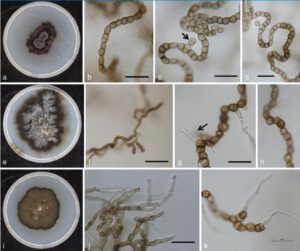Catenulomyces Egidi & de Hoog, in Crous, Schumacher, Akulov, Thangavel, Hernández-Restrepo, Carnegie, Cheewangkoon, R; Wingfield, Summerell, Quaedvlieg, Coutinho, Roux, Wood, Giraldo & Groenewald, Fungal Systematics and Evolution 3: 126 (2019)
Index Fungorum number: IF 829386; Facesoffungi number: FoF 11080
Synonym: Catenulomyces convolutus Egidi & de Hoog, Fungal Diversity 65: 154. 2014. Nom. inval., Art. 40.7 (Shenzhen)
Etymology – named after the conidial chains and curly shape of conidia.
Colonies attaining up to 50 mm in diameter in 12 weeks, black in reverse, white or grey in the obverse, becoming brown or black in the periphery, compact, lobed, cerebriform, with irregular margin. Conidia septate, guttulate, hyaline to dark brown, consisting of cylindrical cells, with thick walls, developing 2 or more longitudinal and/or oblique septa; bulbil-like, brown, intercalary bodies present. Teleomorph unknown.
Typus – Spain, La Cabrera, from rock (holotype CBS 118609, culture and specimen preserved as metabolically inactive).
Notes – The isolate clustered in a separate and external position to Ramimonilia apicalis and Phaeotheca triangularis clades.

Figure 1. a–d Catenulomyces convolutus CBS 118609 = TRN9. a Colony appearance. b–d Mature conidial chains and large conidia with transverse septa (C, arrow). Scale bars 10 μm
